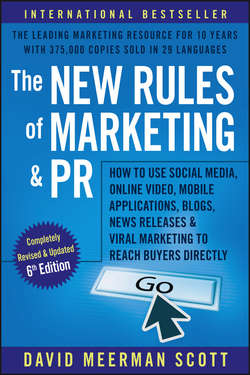Читать книгу The New Rules of Marketing and PR - Scott David Meerman - Страница 6
На сайте Литреса книга снята с продажи.
FOREWORD
ОглавлениеYou're not supposed to be able to do what David Meerman Scott is about to tell you in this book. You're not supposed to be able to carry around a $250 video camera, record what employees are working on and what they think of the products they are building, and publish those videos on the Internet. But that's what I did at Microsoft, building an audience of more than 4 million unique visitors a month.
You're not supposed to be able to do what Stormhoek did. A winery in South Africa, it doubled sales in a year using the principles discussed here.
Something has changed in the past 10 years. The word-of-mouth network has gotten more efficient – much, much more efficient.
Word of mouth has always been important to business. When I helped run a Silicon Valley camera store in the 1980s, about 80 percent of our sales came from it. “Where should I buy a camera this weekend?” you might have heard in a lunchroom back then. Today that conversation is happening online. But instead of only two people talking about your business, now thousands and sometimes millions are either participating or listening in.
What does this mean? Well, now there's a new medium to deal with. Your PR teams had better understand what drives this new medium (it's as influential as the New York Times or CNN now), and if you understand how to use it, you can drive buzz, new product feedback, sales, and more.
But first you'll have to learn to break the old rules.
Is your marketing department saying you need to spend $80,000 to do a single video? (That's not unusual, even in today's world. I just participated in such a video for a sponsor of mine.) If so, tell that department, “Thanks, but no thanks.” Or even better, search Google for “Will it blend?” You'll find a Utah blender company that got 6 million downloads in less than 10 days. Oh, and 10,000 comments in the same period of time. All by spending a few hundred bucks, recording a one-minute video, and uploading that to YouTube.
Or study what I did at Microsoft with a blog and a video camera. The Economist magazine said I put a human face on Microsoft. Imagine that. A 60,000-employee organization, and I changed its image with very little expense and hardly a committee in sight.
This advice isn't for everyone, though. Most people don't like running fast in business. They feel more comfortable if there are lots of checks and balances or committees to cover their asses. Or they don't want to destroy the morale of PR and marketing departments due to the disintermediating effects of the Internet.
After all, you can type “OneNote Blog” into Google, Bing, or Yahoo! and you'll find the OneNote team at Microsoft. You can leave a comment and tell them their product sucks and see what they do in response. Or even better, tell them how to earn your sale. Do they snap into place?
It's a new world you're about to enter, one where relationships with influentials and search engine optimization strategy are equally important, and one where your news will be passed around the world very quickly.
You don't believe me?
Look at how the world found out I was leaving Microsoft for a Silicon Valley start-up.
I told 15 people at a videoblogging conference – not A-listers, either, just everyday videobloggers. I asked them not to tell anyone until Tuesday – this was on a Saturday afternoon, and I still hadn't told my boss.
Well, of course, someone leaked that information. But it didn't pop up in the New York Times. It wasn't discussed on CNN. No, it was a blogger I had never even heard of who posted the info first.
Within hours, it was on hundreds of other blogs. Within two days, it was in the Wall Street Journal, in the New York Times, on the front page of the BBC website, in BusinessWeek, in the Economist, in more than 140 newspapers around the world (friends called me from Australia, Germany, Israel, and England, among other countries), and in other places. Waggener Edstrom, Microsoft's PR agency, was keeping track and said that about 50 million media impressions occurred on my name in the first week.
All due to 15 conversations. Whoa, what's up here? Well, if you have a story worth repeating, bloggers, podcasters, and videobloggers (among other influentials) will repeat your story all over the world, potentially bringing hundreds of thousands or millions of people your way.
How did that happen? Well, for one, lots of people knew me, knew my phone number, knew what kind of car I drove, knew my wife and son, knew my best friends, knew where I worked, and had heard me in about 700 videos that I posted at http://channel9.msdn.com on behalf of Microsoft.
They also knew where I had gone to college (and high school and middle school) and countless other details about me. How do you know they knew all this? Well, they wrote a page on Wikipedia about me – not a single thing on that page was written by me.
What did all that knowledge of me turn into? Credibility and authority. Translation: People knew me, knew where I was coming from, knew I was passionate and authoritative about technology, and came to trust me where they wouldn't trust most corporate authorities.
By reading this book, you'll understand how to gain the credibility you need to build your business. Enjoy!
– Robert Scoble
Co-author, Naked Conversations
@scobleizer
